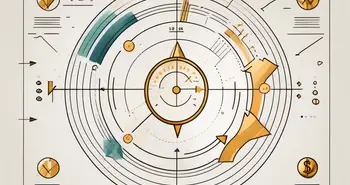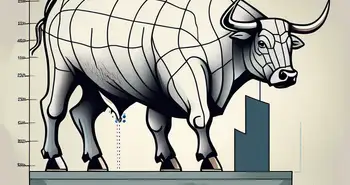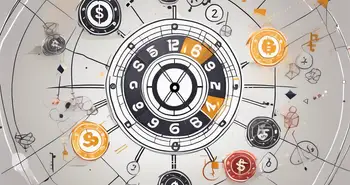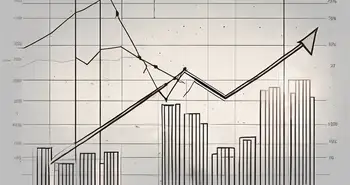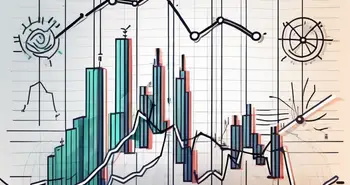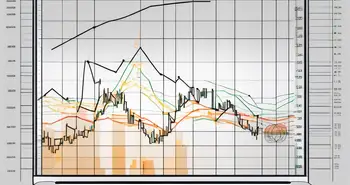Mastering Renko Chart Patterns
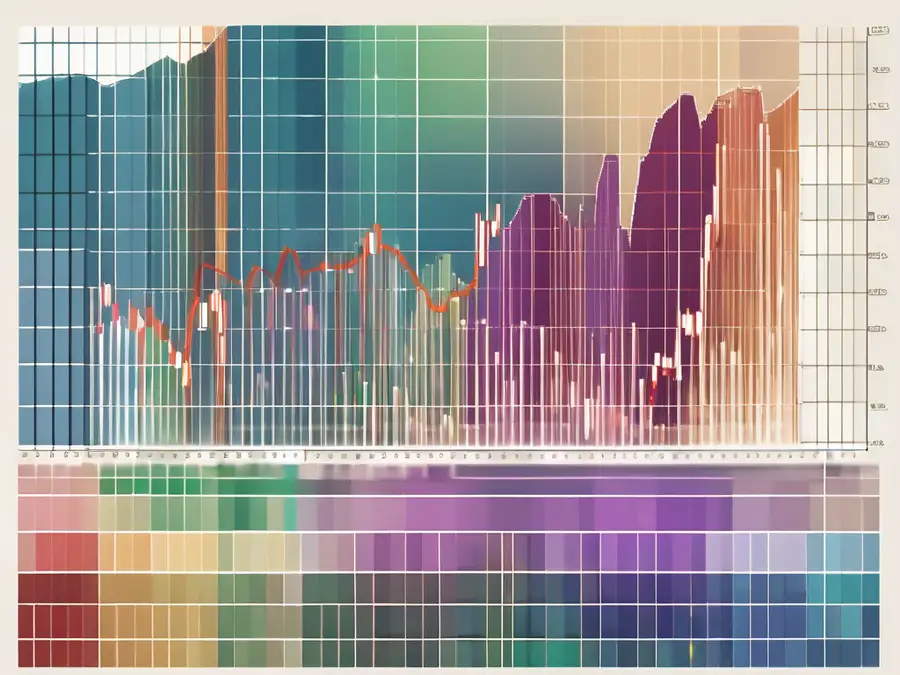
Renko charts are a powerful tool in technical analysis that can help traders gain an edge in the market. In this comprehensive guide, I will take you through the basics of Renko charts, the anatomy of Renko chart patterns, their role in technical analysis, strategies for trading with Renko charts, and advanced techniques in Renko chart analysis. By the end of this guide, you will have a solid understanding of Renko charts and be equipped with the knowledge to incorporate them into your trading arsenal.
Understanding the Basics of Renko Charts
Renko charts originated in Japan and have been used for centuries to analyze price movements. Unlike traditional candlestick or bar charts, Renko charts focus solely on price action while ignoring time and volume. This unique characteristic enables traders to identify trends and key price levels with precision.
Renko charts are constructed by plotting bricks or boxes on the chart. The size of the bricks is determined by the user and represents a specific price movement. When prices move above or below the previous brick's high or low, a new brick is formed. This methodology filters out minor price fluctuations, providing a clearer picture of the market's overall trend.
Knowing the history and development of Renko charts is essential to truly grasp their significance. The concept of Renko charts was introduced by the Japanese in the late 18th century. Renko, which means “brick” in Japanese, aptly describes the chart's construction. Over the years, traders around the world have recognized the benefits of Renko charts and incorporated them into their trading strategies.
Renko charts have stood the test of time due to their simplicity and effectiveness. By following the “Keep it Simple” principle, Renko charts focus solely on price movements, eliminating the noise created by time-based charts. This allows traders to spot trends more easily and make informed decisions. Additionally, Renko charts emphasize key support and resistance levels, enabling traders to identify crucial entry and exit points.
One of the key advantages of Renko charts is their ability to filter out market noise. Traditional time-based charts can be cluttered with irrelevant price fluctuations, making it difficult for traders to identify the underlying trend. Renko charts, on the other hand, provide a clear visual representation of price movements, allowing traders to see the bigger picture.
Another benefit of Renko charts is their ability to highlight key support and resistance levels. These levels are crucial for traders as they indicate areas where the price is likely to reverse or consolidate. By focusing on these levels, traders can make more accurate predictions and improve their overall trading performance.
In conclusion, Renko charts offer a unique perspective on price movements, allowing traders to analyze trends and key price levels with precision. By filtering out minor price fluctuations and emphasizing support and resistance levels, Renko charts provide a clearer and more simplified view of the market. Understanding the history, development, and fundamental principles of Renko charts is crucial for traders looking to incorporate this powerful tool into their trading strategies.
The Anatomy of Renko Chart Patterns
Identifying key Renko chart patterns is essential for traders to capitalize on market opportunities. Renko chart patterns offer valuable insights into market sentiment and the potential direction of prices. By recognizing these patterns, traders can enter or exit trades at favorable times.
Renko chart patterns come in various forms, including basic patterns like the single brick reversal pattern, double brick reversal pattern, and triple brick reversal pattern. Each pattern conveys a different message about market sentiment, ranging from trend continuation to trend reversal. Understanding these patterns is crucial for successful trading with Renko charts.
In addition to their individual significance, different Renko patterns also play a collective role in determining market trends. By analyzing the overall sequence of Renko patterns, traders can identify the strength and sustainability of a trend. This information is invaluable for making informed trading decisions and managing risk.
Moreover, Renko chart patterns can be combined with other technical analysis tools to enhance trading strategies. For example, traders often use moving averages in conjunction with Renko charts to confirm trend signals. The intersection of Renko patterns with key moving averages can provide powerful insights into potential price movements.
Furthermore, advanced traders may incorporate Fibonacci retracement levels into their analysis of Renko chart patterns. Fibonacci levels can act as support or resistance zones, adding another layer of confluence to trading decisions based on Renko patterns. By integrating multiple technical indicators, traders can increase the accuracy of their predictions and improve their overall trading performance.
The Role of Renko Charts in Technical Analysis
Renko charts are a powerful tool that can complement other technical indicators. While traditional charts provide valuable information, they can sometimes be cluttered with noise, making it difficult to spot trends. By incorporating Renko charts into your analysis, you can filter out the noise and focus on the essential elements of price action.
However, it is essential to be aware of the limitations of Renko charts in market analysis. Renko charts do not factor in time and volume, which can be crucial in certain situations. Therefore, it is important to also consider other technical indicators that provide complementary information. Using Renko charts in combination with traditional charts and indicators can enhance your analysis and improve your trading decisions.
Strategies for Trading with Renko Charts
Timing trades with Renko chart patterns is a skill that can greatly enhance your trading success. By properly interpreting Renko patterns and matching them with other technical indicators, you can identify optimal entry and exit points. It is crucial to understand that Renko patterns alone do not guarantee profitable trades. Proper risk management, market conditions, and other factors must also be taken into account.
Risk management is an integral part of trading with Renko charts. As with any trading strategy, it is essential to determine the appropriate position size and set stop-loss levels to protect your capital. By combining Renko patterns with risk management techniques, you can maximize your chances of success and minimize potential losses.
Advanced Techniques in Renko Chart Analysis
Combining Renko charts with other chart types can unlock advanced analysis techniques that offer deeper insights into market dynamics. By incorporating candlestick charts, line charts, or bar charts alongside Renko charts, traders can gather a more comprehensive view of price action.
Fine-tuning your Renko chart analysis skills is a continuous process that requires practice and experience. As you become more comfortable with Renko charts, you can experiment with different brick sizes, time frames, and indicators to further refine your trading strategies.
My personal advice to aspiring Renko chart traders is to start small and gradually increase your position sizes as you gain confidence in your analysis. It's also important to keep a trading journal, where you can record your trades, emotions, and observations. This will help you identify patterns in your trading behavior and make improvements over time.
FAQ: Frequently Asked Questions
Q: Are Renko charts suitable for all types of traders?
A: Renko charts can be beneficial for all types of traders, including day traders, swing traders, and long-term investors. The key is to adapt your trading strategy to match the time frame and objectives that align with your trading style.
Q: How often should I analyze Renko charts?
A: The frequency of Renko chart analysis depends on your trading strategy and time horizon. Some traders may analyze Renko charts on a daily basis, while others may rely on weekly or monthly analysis. It's essential to find a frequency that suits your trading style and objectives.
Q: Can Renko charts be used in conjunction with other technical indicators?
A: Yes, Renko charts can be combined with other technical indicators to enhance your analysis. By incorporating indicators like moving averages, trend lines, and oscillators, you can gain additional confirmation or identify potential trade setups.
Q: How do I determine the optimal brick size for Renko charts?
A: The optimal brick size for Renko charts depends on the volatility of the asset you are trading and your trading objectives. A smaller brick size will capture more price movements but may result in more noise, while a larger brick size will filter out minor price fluctuations but may lag behind significant trends. It's important to experiment and find the brick size that best suits your trading style.
Renko charts are a valuable tool in a trader's arsenal, providing simplicity and clarity in price analysis. By understanding the basics, recognizing key patterns, and combining Renko charts with other technical indicators, you can master the art of Renko chart trading. Remember to practice patience, discipline, and risk management in your trading journey, and always adapt your strategies to changing market conditions. Happy trading!
Ready to put your Renko chart mastery into practice? Look no further than Morpher, the revolutionary trading platform that's changing the game with blockchain technology. With Morpher, you can trade a variety of asset classes, from stocks and cryptocurrencies to forex and even niche markets, all with zero fees and infinite liquidity. Embrace the power of fractional investing, short selling without interest fees, and up to 10x leverage to amplify your trades. Plus, with the Morpher Wallet, you maintain complete control over your funds. Experience a unique trading environment with Virtual Futures on the Ethereum Blockchain. Sign Up and Get Your Free Sign Up Bonus today to start trading on a platform that's as innovative as your strategies. Happy trading with Morpher!

Disclaimer: All investments involve risk, and the past performance of a security, industry, sector, market, financial product, trading strategy, or individual’s trading does not guarantee future results or returns. Investors are fully responsible for any investment decisions they make. Such decisions should be based solely on an evaluation of their financial circumstances, investment objectives, risk tolerance, and liquidity needs. This post does not constitute investment advice.

Painless trading for everyone
Hundreds of markets all in one place - Apple, Bitcoin, Gold, Watches, NFTs, Sneakers and so much more.

Painless trading for everyone
Hundreds of markets all in one place - Apple, Bitcoin, Gold, Watches, NFTs, Sneakers and so much more.

